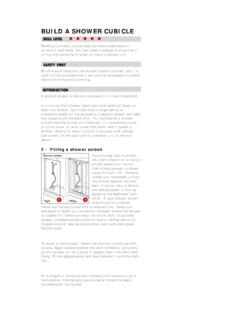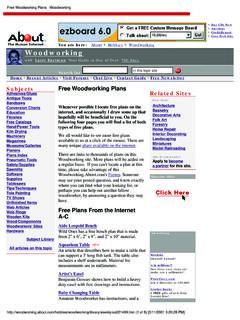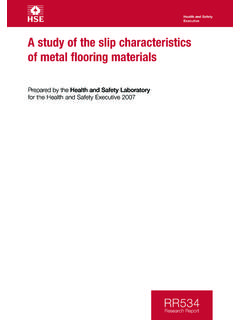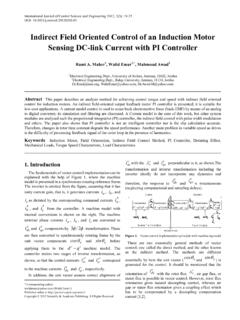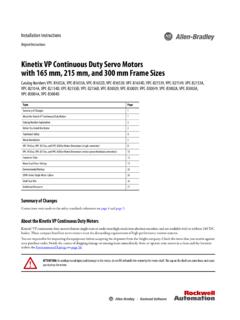Transcription of BASIC PLUMBING - Wood Tools
1 BASIC PLUMBING The simple skills required for BASIC PLUMBING are explained inthis project. It helps to have some metalworking experience. Take care when working with a blowtorch in loft spaces. Be aware that pipes take time to cool after exposure to the blowtorch flame. If you can undertake the BASIC work yourself, you save money and the inconvenience of waiting for a plumber. BASIC PLUMBING repair needn't be a daunting task, all you need to get started are a few essential Tools , a working knowledge of your system and an ability to identify problems. 2 - Preparation Step 1: Familiarise yourself with the layout of your PLUMBING - this will enable you to identify the cause of a problem and shut off the water for servicing.
2 Step 2: Locate the stopcock on the rising main - the pipe that brings fresh water into your home. The stopcock controls the flow of water ais used to shut off the entiresupply in an emergencystopcock may be found undnd . The er the kitchen sink, beneath thstairs or in the cellar or basement. e Step 3: Check if there are isolating valves on the low pressure pipes to taps, toilet cisterns and household appliances - these valves enable servicing to be carried out without turning off the mains. They are usually located next to the storage cistern in the loft. Make up a kit of BASIC PLUMBING Tools and a set of spare washers to fit the taps and valves around the house. Keep your plumber's phone number handy in case you are faced with a serious problem.
3 3 - Draining the system In order to repair a leak, run new pipes or service a toilet cistern, it is necessary to be able to drain various parts of the system. Water is supplied to a house under relatively high mains pressure. In most houses it is directed via the rising main pipe to a cold water storage cistern in the loft. A pipe connected to the rising main feeds drinking water directly to the kitchen sink. All other taps and fittings, including the hot water storage cylinder, are supplied indirectly by a low pressure gravity-fed system from the storage cistern. To drain the cold water kitchen tap and pipe: 1. Close the stopcock on the rising main 2. Open the tap to empty the short length of pipe.
4 To drain cold water taps in the bathroom/to drain the cistern: 1. Shut off the cold feed valve from the storage cisternin the loft. 2. Run the bathroom taps. or: 1. If there is no isolating valve, shut off the supply of water to the cistern by tying the arm of the float valve to a batten placed across the top. 2. Run the taps to dthe cistern. Use this method if you ever need to work on thcistern itself. rain e o drain a toilet cistern: 1. Tie up the float-valve arm. T 2. Flush the toilet. u need to work on the If yosupply pipe to the cistern, shut er supply from the storage cistern in the loft (see drain hot water taps: 1. Turn off the immersion heater and the central heating boiler. to the hot water cylinder.)
5 To d hose to the draincock at the base of the cylinder. If e cylinder contains a heat exchanger fed from the boiler, ning pipes for minor a valves to divide the Step 1: Fit gate valves on the cold feed pipes from the g Fit isolator valves in the supply pipes to taps and 5 - Filling the system tep 1: First close all taps and drainage points, then open the float valves operate off the watabove). To 2. Shut off the supply of water from the storage cistern in the loft 3. Run off the water from the hot taps. rain the hot water cylinder: Attach a ththis can only be emptied through the boiler draincock. 4 - Fitting extra valves To save time and water when draiepairs and servicing, install extrrsystem into sections or to isolate individual fittings and appliances.
6 Storage cistern. This will save you having to drain the stored water when servicinthe low pressure side of the system. If you fit a second stopcock on the in-feed pipe, you can drain the cistern without turning off the rising main. Step 2: appliances. This will enable you to isolate the individual fitting for servicing. Sthe main stopcock. Check thatproperly as the water levels rise in the storage cisterns. If water pours from a cistern overflow, the valve may havestuck open. Work the float arm up and down a few times tofree the valve. tep 2: When the system is full, open the taps. Water is ely to splutter out at first as trapped air is released. tep 3: If water fails to flow or only trickles out, there may e an airlock.
7 Connect a length of garden hose to the high Opening both taps allows the high pressure water to push e time em. If no success, call a plumber. mm and sometimes Slik Sbpressure kitchen tap at one end and the airlocked tap at the other. trapped air out of the pipe. Turn off the taps, disconnect the hose and test the airlocked tap again. Repeat if necessary allowing morfor the air to clear. Should the air lock not clear, try again by entering the syst 6 - Cutting & joining pipes Most homes are plumbed with 15mm, 22 28mm diameter copper pipe. Joining pipework is BASIC to all opper pipes can be joined with brass compressn fittings r soldered capillary joints. You can cut copper pipe with a hatever type of fitting you use, the pipe must first be cut erfectly square.
8 To cut a pipe, lightly clamp the cutter on the pipe, with ntil PLUMBING installations and many repairs. Cioofine toothed hacksaw, but it is easier and more accurate if you use a tube cutter. Wp the cutting wheel on the cut line. Rotate the cutter aroundthe pipe, tightening it a little after each revolution, uthe pipe is severed. Remove burrs from inside the cut end, using the pointed o join copper pipes with a compression fitting: tep 1: First remove the cap nut and slide it over the end ofmove burrs from inside the cut end, using the pointed o join copper pipes with a compression fitting: tep 1: First remove the cap nut and slide it over the end ofreamer on the cutting tool or use a small half-round file.
9 Reamer on the cutting tool or use a small half-round file. TT SS the pipe. tep 2: Slip the brass ring, known as an olive, onto the tep 3: Push the pipe into the body of the fitting, slide the tep 4: Tighten the nut fully with a pair of spanners, one to or soldered joints, use pre-soldered fittings as these tep 1: Clean the cut ends of the pipes and the inside of the tep 2: Apply a paste flux to the fitting and pipes, then Step 3: Using a heatproof tep 4: Remove the heat and leave the metal to cool. - Mending damaged pipes copper pipe under Spipe. Solive up to the fitting and tighten the nut by hand. Shold the body of the fitting, and the other the nut. Assemble the other half of the fitting in the same way.
10 Fare easier to work with: Sfitting to a bright finish, using wire wool. Spush the parts together. mat as a shield behind the fitting, evenly heat the joint with the flame of a gas blowtorch until a rim of shiny solder appears around the ends of the fitting. S 7 If you accidentally drive a nail through athe floor, you may not even notice for a while. The only indication is a faint hissing until, eventually, a damp patch appears on the ceiling in the room below. If your floors are to be carpeted or covered with sheet vinyl, aint the lines of hidden PLUMBING across the floorboards to tep 1: Identify the system which is supplying the pipe. ater is supplied to a house under relatively high mains ressure.
